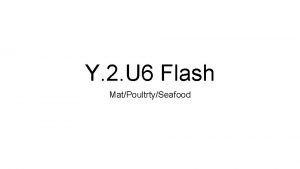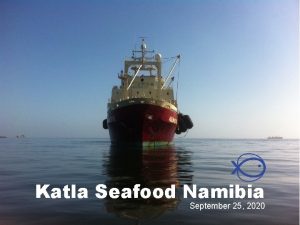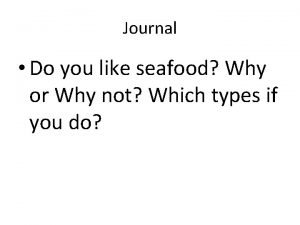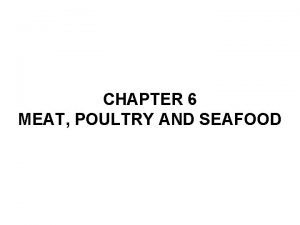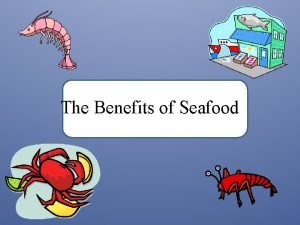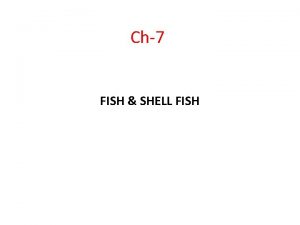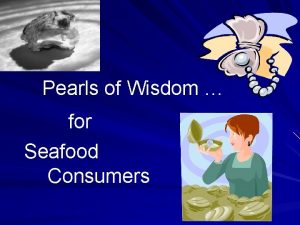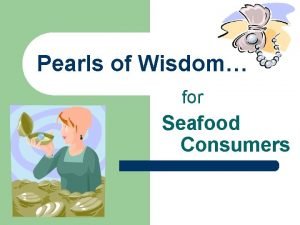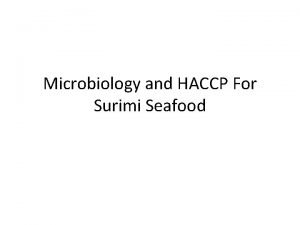Fish Seafood There are three types White fish










- Slides: 10

Fish

Seafood- There are three types White fish Cod haddock plaice whiting pollock coley dover sole less than 5% fat in their flesh. Oily fish Shellfish herring mackerel sardines whitebait tuna (only Molluscs counted as an oily fish if it is fresh or frozen) 10 -20% fat in their flesh scallops oysters cockles mussels winkles Crustacea prawns scampi crabs lobsters shrimps Octopus squid cuttlefish

Nutrition Scientists suggest that we eat at least two portions of fish a week, one of which should be oil rich. Fish is a good source of protein and contains the essential fatty acids that cannot be made by the body and are needed for cell membranes. Fish is low in calories, a good source of the minerals iron, zinc, iodine and selenium and the B group vitamins

Nutrition - Oily fish 10 -20% fat in their flesh (White fish less than 5% fat in - rich sources of the fat Salmon is one soluble vitamins A of the major and D which are sources important for growth and bones - good source of omega 3 (found in oilrich fish and some plant oil) fatty acids their flesh. ) fatty acids are… - the building blocks of fats - important for a healthy heart, (lowering cholesterol levels and keeping our body healthy) - Some fatty acids are made by the body - some like Omega 3 fatty acids, cannot be made, and must be supplied by the diet

Ways to buy fish Fresh from a fishmonger or supermarket – you have a choice of freshly caught fish Frozen from the freezer of a supermarket – the fish is often cut into portions and has been frozen quickly after it is caught Canned fish -such as canned salmon, mackerel and pilchards Smoked fish -such as haddock and salmon which helps preserve and flavour the fish

Cooking fish Fresh fish cooks very quickly and if it is overcooked it becomes tough and dry During cooking the fish muscles shrink and moisture is squeezed out The connective tissue in fish is called collagen and this changes into gelatine during cooking.

Fish quality The most important factor when handling fish is that it is highly perishable and it quickly deteriorates. There a number of factors which affect the initial fish quality: 1. Time of capture 2. Place of capture 3. How much the fish fights 4. How it is stored after death Fish muscles also contain glycogen (like meat) and the process of rigor mortis also occurs. However glycogen levels may be low in poor quality fish. Little lactic acid is produced after death. If the p. H is high it will mean soft flesh in the fish which is not desirable. Fish cannot be rested after death and some fight during capture which results in less glycogen in the fish and the p. H is about 6. 5 compared to meat which is 5. 6 or less. Fish go into rigor pretty much straight away which can cause bacterial

Stinky fish Fish flesh contains nitrogen containing compound trimethylamine oxide which is broken down by bacteria to produce trimethylamine. This gives the characteristic bad fish smell. Ammonia is often produced by bacteria when they attack the protein in the fish muscle. This adds to the bad smell. Any liquid material in fish is usually highly unsaturated particularly oils in fatty fish which can be susceptible to oxidative rancidity. This is also an indicator of poor quality fish. The smell of fresh fish is due in part to inosinic acid. When

Fish preservation chilling The lower the temperature the slower the bacteria and enzyme activity in fish. This means a longer shelf life. Fish can be chilled or frozen. Chilling (icing) - ice is ideal for chilling fish and it can be stored in it for up to a month. Fish has a relatively large cooling capacity for good chilling of the fish the ice must be melting which has the added advantage of washing the fish and keeping it moist. Fresh water fish last longer in ice compared with salt water species. Non fatty fish has a longer shelf life than fatty fish. Chilled water/ refrigerated sea water is now becoming popular in areas which cannot produce ice. (RSW – refrigerated sea water)

Freezing fish Freezing – freezing fish after preparation at sea and storing at about 30 C can extend the shelf life of most fish to several months or even up to a year. Enzymic and bacterial action is almost completely stopped at this temperature and water required for bacterial growth and enzymic activity is effectively removed and locked away as ice. The freezing operation may reduce the number of micro organisms in frozen fish but on thawing numbers will more than make up for the decrease. Poor quality fish will be worse after freezing. Only the freshest raw fish should be frozen. Often fish is glazed after freezing by dipping them into water so that a film of ice forms on the surface of the fish. This prevents freezer burn which is dehydration caused by lack of water from the surface of the fish. This also prevents oxidation of any fat by acting as a barrier against air.
 Antigentest åre
Antigentest åre One fish two fish red fish blue fish ride
One fish two fish red fish blue fish ride One fish two fish blowfish blue fish
One fish two fish blowfish blue fish One fish two fish red fish lungfish
One fish two fish red fish lungfish Which category of shellfish includes those with tentacles?
Which category of shellfish includes those with tentacles? Fishandkids
Fishandkids Katla seafood
Katla seafood Hidangan seafood kontinental
Hidangan seafood kontinental Katla seafood
Katla seafood A ________ has the entrails, head, fins, and scales removed
A ________ has the entrails, head, fins, and scales removed Squab forcemeat
Squab forcemeat




